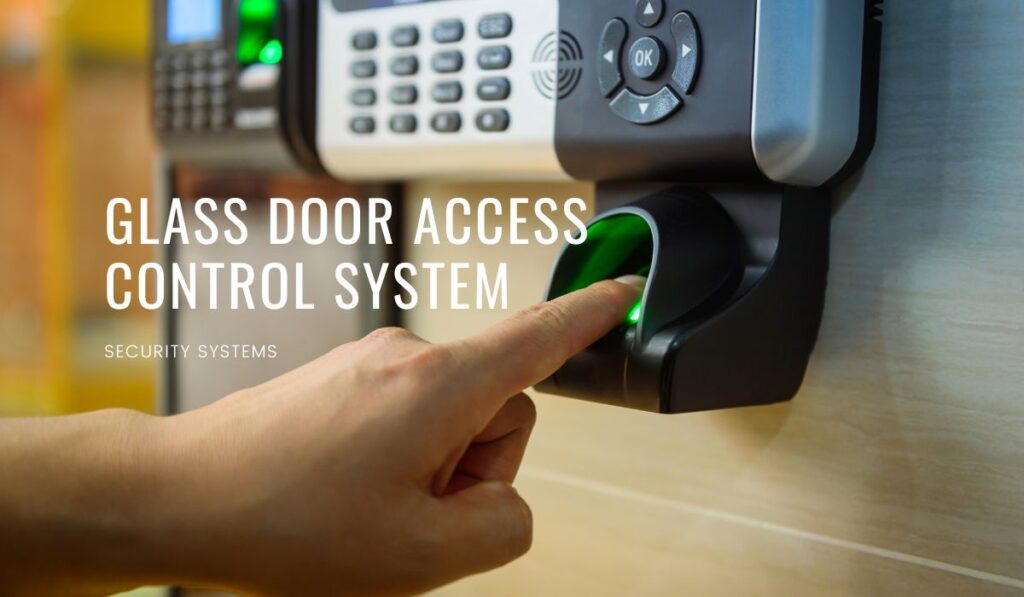In today’s modern buildings, glass doors are more than just aesthetic elements. They provide natural light, create open spaces, and foster a sense of transparency. However, this emphasis on openness necessitates robust security measures, particularly for access control. Glass door access control systems bridge this gap, seamlessly integrating security with the inherent openness of glass doors.
What is a glass door access control system?
A glass door access control system is an electronic security system that restricts access to specific areas through a glass door. It typically comprises three key components:
- Credentials: These verify the identity of individuals seeking access. Common credentials include key fobs, proximity cards, PIN codes, biometrics (fingerprint or facial recognition), and even smartphones.
- Reader: This device reads the presented credential and transmits the information to the control panel. Readers can be standalone units mounted near the door or integrated into the door frame itself.
- Control Panel: This central unit processes the information received from the reader and determines whether to grant or deny access based on programmed rules and permissions.
Benefits of Glass Door Access Control Systems:
- Enhanced Security: Glass door access control systems restrict unauthorized entry, deterring theft and vandalism.
- Improved Access Management: Granular control over who can access specific areas and at what times is possible.
- Increased Convenience: Keyless entry with fobs or smartphones eliminates the need for physical keys.
- Streamlined Attendance Tracking: Integration with time and attendance systems enables automated employee tracking.
- Boosted Building Aesthetics: Discreetly installed readers and sleek door locks maintain the clean lines of glass doors.
Types of Glass Door Access Control Systems:
- Magnetic Lock Systems: These use electromagnets to secure the door when not in use. They are a popular choice for single doors and require minimal hardware modifications.
- Electric Strike Systems: These work with existing door strikes and deadbolts, making them suitable for retrofitting existing doors.
- Drop Bolt Locks: These extend a bolt downwards to secure the door and are often used for frameless glass doors.
Considerations for Choosing a Glass Door Access Control System:
- Security Level: Assess the level of security required for your building and choose a system with appropriate credential verification methods.
- Door Type: Ensure the chosen system is compatible with your specific door type, frame, and material.
- Integration Needs: Consider whether you need integration with existing systems like time and attendance or video surveillance.
- Budget: System costs vary based on features, complexity, and brand.
Case Studies: Glass Door Access Control Systems Enhancing Security and Style
Glass doors are increasingly sought-after for their aesthetic appeal, offering transparency and openness while still providing physical separation. However, integrating traditional access control systems with glass doors can pose unique challenges. This article explores two impactful case studies showcasing how innovative solutions overcome these challenges and deliver enhanced security along with aesthetic appeal.
Case Study 1: Secured Elegance: High-Rise Office Building
Challenge: A newly constructed high-rise office building faced the dilemma of maintaining its sleek, glass-walled design while implementing a robust access control system. Traditional card readers and bulky hardware compromised the desired aesthetic.
Solution: The building opted for a wireless access control system utilizing sleek, low-profile readers mounted directly on the glass. These readers incorporated Bluetooth Low Energy (BLE) technology, allowing authorized personnel to gain access using smartphones or wearable credentials. This eliminated the need for unsightly wires and bulky hardware, preserving the elegant design.
Results: The implemented system not only enhanced security but also streamlined access control. Employees enjoyed the convenience of using their smartphones, and the building management benefited from enhanced audit trails and remote access management capabilities. The integration of the access control system with the building’s automation system further optimized energy consumption and improved visitor management.
Case Study 2: Controlled Openness at the University Library
Challenge: A university library sought to balance open access with the need to secure valuable resources and restricted areas. While welcoming public visitors, the library needed to protect sensitive materials and restrict access to certain sections. Traditional turnstiles or locked doors hindered the desired open library atmosphere.
Solution: The library implemented a hybrid access control system utilizing facial recognition technology for authorized personnel and RFID-enabled cards for public access. The facial recognition system allowed authorized individuals to seamlessly enter secured areas without interrupting the open flow of people. Public visitors could access the library using RFID cards, maintaining a welcoming environment.
Results: This solution successfully delivered enhanced security while preserving the library’s open atmosphere. Theft rates of valuable resources significantly decreased, and unauthorized access to restricted areas was effectively prevented. Additionally, the facial recognition system eliminated the need for physical keys or cards, reducing administrative costs and improving convenience for authorized personnel.
Lessons Learned:
These case studies illustrate the versatility and adaptability of modern access control systems for glass doors. Key takeaways include:
- Prioritization: Clearly define security needs and aesthetic considerations before choosing a solution.
- Technology Innovation: Embrace innovative technologies like wireless readers, BLE, and facial recognition to overcome aesthetic challenges.
- Hybrid Solutions: Combining different technologies can cater to diverse user groups and access levels.
- Integration: Integrate access control with building automation systems for enhanced security and operational efficiency.
FAQs about Glass Door Access Control Systems:
While no system is foolproof, choosing a reputable brand with strong encryption and secure communication protocols can significantly mitigate hacking risks.
Many systems have fail-safe mechanisms that automatically unlock the door during a power outage to ensure safe egress.
Regular cleaning of the reader and periodic system checks are essential for optimal performance.
While DIY options exist, professional installation is recommended for complex systems or doors with unique requirements.
Costs vary depending on the system’s features, complexity, and number of doors. Expect to spend anywhere from a few hundred to several t
Conclusion:
Glass door access control systems offer a blend of security, convenience, and aesthetics, making them ideal for modern buildings. By carefully considering your needs and choosing the right system, you can transform your glass doors from potential vulnerabilities into secure and controlled entry points.


